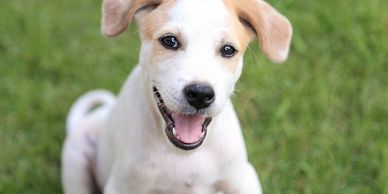Signed in as:
filler@godaddy.com
Signed in as:
filler@godaddy.com
You've read all the information on whether your pet is the right age, at the right stage of their cycle (if applicable), and whether they need a pre-op health check in advance, and now you're ready to book! Please head to the 'online appointments' page. If this is not immediately apparent, it can be found either by clicking on the 'schedule appointment' button on the home page, or by clicking 'more' on the menu at the top right-hand side of the home page.

If you have a female dog that you need spayed, you will need to wait 3-4 months from the start of her last heat cycle. This is because higher levels of oestrogen are associated with increased blood flow to the reproductive organs, and can increase the risk of excessive bleeding.
Current advice is that female dogs should be allowed to have one heat cycle before being spayed. This is to ensure a balance between the risks and benefits of spaying - the risk of mammary tumours increases with subsequent cycles while the risk of urinary incontinence is higher if a heat cycle has not occurred. There are exceptions for large breed or giant dogs, which need to reach skeletal maturity before sterilisation.
Cats should be neutered between four and six months' age, and weigh at least 2 kilos. This is done to avoid them becoming sexually active, which can occur as young as six months old. Some cats will develop unwanted habits at this point such as spraying or marking.
The size of a dog will determine the recommended age of neutering. Toy and small breed dogs can be neutered as young as nine months, although females should have had one heat cycle. Medium-sized dogs should be neutered at around one year, and large and giant breed dogs at around 18 months. These are the points at which they have passed skeletal maturity, which requires the presence of sex hormones to complete.
Your pet will need a pre-operative health check prior to their neuter surgery. We can perform a pre-operative health check on cats on the day of their surgery to minimise their stress levels. Dogs need to be seen before their surgery day if they are not taking any flea or worming that covers for lungworm, as we cannot prescribe a wormer without examining your dog. Lungworm treatment needs to be given at least a week before a surgery (with a maximum of six weeks). This is because lungworm infection can be present without any symptoms, and can cause excessive bleeding during surgery. Over the count flea and worming products such as Frontline or any fipronil based product, Advantage, Bob Martin etc, does NOT cover for lungworm. We use Milpro (milbemycin) 125mg tablets for dogs which are £9, this dose is good for one dog between 5kg and 25kg. Dogs from 25-50kg require two tablets and dogs over 50kg require three tablets. Dogs under 5kg have puppy-sized tablets for £5.
Lungworm infection is not commonly diagnosed but we know it is present, we cannot tell which dogs have it and one of the first signs can be sudden death from internal bleeding. It is not worth taking any risks.
You do not need to bring or do anything to prepare for a pre-op check.
The night before surgery, take away your pet's food. You can leave the water down, but pick it up in the morning when you get up.
You may want to bring a T-shirt, blanket, toy etc on the day of surgery so that your pet can have a comfort item that reminds them of home. You should also bring Buster collar, medical shirt or inflatable collar so that it can be fitted while your pet is under anaesthesia. Some pets attempt to lick their wound immediately upon recovery, so this helps to prevent any self-inflicted damage. You can purchase one of these items from us if you prefer; alternatively they can be found at most pet shops or online.
The prices quoted are inclusive of the pre-op health check, anaesthetic, surgery, medication including pain medication to go home, and two post operative checks as needed.
The only additional costs you are likely to incur are any lungworm treatment if not already taking prescription parasite treatment (this is £9 for most dogs, not needed in cats or other species), and a protective collar or shirt. The cost of a Buster collar can be as little as a couple of pounds, up to the most expensive option such as a medical shirt or inflatable collar for a large dog that can be upwards of £30.